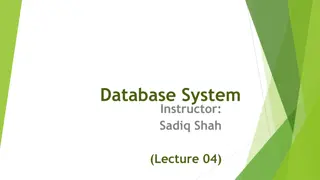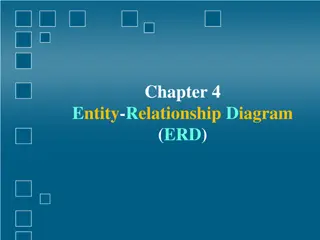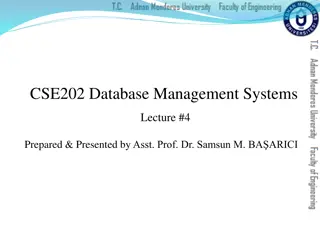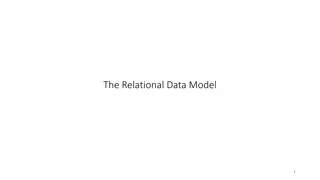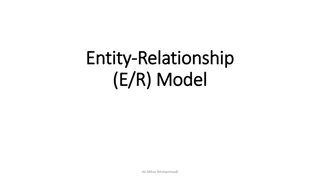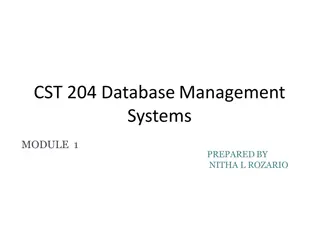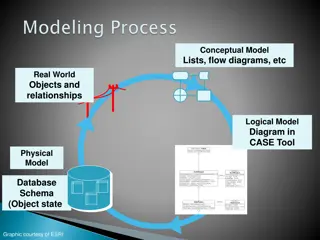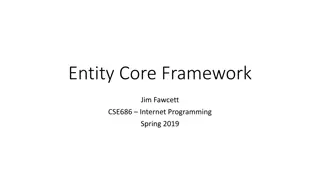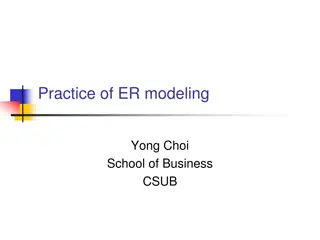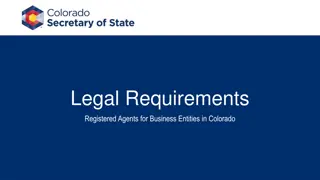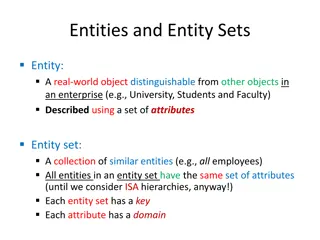Understanding Entity-Relationship Modeling in Database Systems
Explore the concept of Entity-Relationship Modeling in Database Systems through examples like the E-R Model, E-R Diagrams, and Business Rules. Learn about entities, relationships, attributes, and cardinalities to design efficient databases.
Download Presentation

Please find below an Image/Link to download the presentation.
The content on the website is provided AS IS for your information and personal use only. It may not be sold, licensed, or shared on other websites without obtaining consent from the author. Download presentation by click this link. If you encounter any issues during the download, it is possible that the publisher has removed the file from their server.
E N D
Presentation Transcript
Database System Instructor: Sadiq Shah (Lecture 03)
THE E-R MODEL The E-R model is expressed in terms of entities in the business environment, the relationships (or associations) among those entities, and the attributes (or properties) of both the entities and their relationships. A graphical representation of an entity-relationship model.
Example Sample E-R Diagram E-R diagram for a small furniture manufacturing company, Pine Valley Furniture Company. A number of suppliers supply and ship different items to Pine Valley Furniture. The items are assembled into products that are sold to customers who order the products. Each customer order may include one or more lines corresponding to the products appearing on that order.
The entities in Figure include the following: CUSTOMER A person or an organization that has ordered or might order products. A type of furniture made by Pine Valley Furniture that may be ordered by customers. The transaction associated with the sale of one or more products to a customer and identified by a transaction number from sales or accounting. PRODUCT ORDER A type of component that goes into making one or more products and can be supplied by one or more suppliers. ITEM Another company that may provide items to Pine Valley Furniture. SUPPLIER The transaction associated with items received in the same package by Pine Valley Furniture from a supplier. All items in a shipment appear on one bill document. Example: The receipt SHIPMENT
The symbols at the end of each line on an ERD specify relationship cardinalities, which represent how many entities of one kind relate to how many entities of another kind.
Business rules: 1. A SUPPLIER may supply many ITEMs (by may supply, we mean the supplier may not supply any items). Each ITEM is supplied by any number of SUPPLIERs (by is supplied, we mean that the item must be supplied by at least one supplier). 2. Each ITEM must be used in the assembly of at least one PRODUCT and may be used in many products. Conversely, each PRODUCT must use one or more ITEMs 3. A SUPPLIER may send many SHIPMENTs. However, each shipment must be sent by exactly one SUPPLIER. Notice that sends and supplies are separate concepts. 4. A SUPPLIER may be able to supply an item but may not yet have sent any shipments of that item.
Business rules: 6. A SHIPMENT must include one (or more) ITEMs. An ITEM may be included on several SHIPMENTs. 7. ACUSTOMER may submit any number of ORDERs. However, each ORDER must be submitted by exactly one CUSTOMER. Given that a CUSTOMER may not have submitted any ORDERs, some CUSTOMERs must be potential, inactive, or some other customer possibly without any related ORDERs. 8. An ORDER must request one (or more) PRODUCTs. A given PRODUCT may not be requested on any ORDER or may be requested on one or more orders.
E-R Model Notation The notation we use for E-R diagrams is shown in Figure. As indicated in the previous section, there is no industry-standard notation. The notation in Figure combines most of the desirable features of the different notations that are commonly used in E-R drawing tools today
Business Rules A business rule is a statement that defines or constrains some aspect of the business. It is intended to assert business structure or to control or influence the behavior of the business . . . rules prevent, cause, or suggest things to happen For example, the following two statements are common expressions of business rules A student may register for a section of a course only if he or she has successfully completed the prerequisites for that course. A preferred customer qualifies for a 10 percent discount, unless he has an overdue account balance.
GOOD BUSINESS RULES Declarative: A business rule is a statement of policy, not how policy is enforced or conducted; the rule does not describe a process or implementation, but rather describes what a process validates. Precise: With the related organization, the rule must have only one interpretation among all interested people, and its meaning must be clear. Atomic: A business rule marks one statement, not several; no part of the rule can stand on its own as a rule (that is, the rule is indivisible, yet sufficient). Consistent: A business rule must be internally consistent (that is, not contain conflicting statements) and must be consistent with (and not contradict) other rules.
GOOD BUSINESS RULES Expressible: A business rule must be able to be stated in natural language, but it will be stated in a structured natural language so that there is no misinterpretation. Distinct: Business rules are not redundant, but a business rule may refer to other rules (especially to definitions). Business-oriented: A business rule is stated in terms businesspeople can understand, and because it is a statement of business policy, only businesspeople can modify or invalidate a rule; thus, a business rule is owned by the business.






